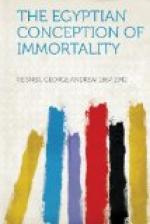But the texts go even further than this and identify the dead god-man, who as Horus was king on earth, with the father of Horus, the dead god of the earth, Osiris. This identification of the dead man with the dead god Osiris was later enlarged to include all men, and became in the Ptolemaic period the most characteristic feature of the Egyptian conception of life after death.
The Osiris story as it can be pieced together from the pyramid texts [See A. Erman: Die Aegyptische Religion, p. 38 ff.] was briefly thus: Keb, the earth-god, and Nut, the goddess of the sky, had four children,—Osiris and Isis, Seth and Nephthys,— who were thus paired in marriage. Keb gave Osiris his dominion, the earth, and made him the god of the earth, and he ruled justly and powerfully. Seth, his brother, was jealous, and by treachery enticed Osiris into a box, which he closed and threw into the water. Isis sought for the body of her husband until she found it, and Isis and Nephthys, her sister, sat at his head and feet and bewailed him. Re, the greatest of the gods, heard Isis’s complaint; his heart was touched, and he sent Anubis to bury Osiris. Anubis re-joined his separated bones, bound him with cloths, and prepared him for burial,—that is, mummified him. This is the form in which Osiris is represented,—as a mummy. Isis then fanned her wings, and the air from her wings caused the mummy to live. His life on earth, however, was over, could not be recalled, so that his new life could only be passed in the other world, the world of the dead. Here Osiris became king, as he had been king on earth. But Isis conceived from the dead-living Osiris, bore a child in secret, and suckled him, hidden in a swamp. When the child, the sun-god Horus, grew up, he fought against Seth to recover his father’s kingdom, and to avenge his death. Both gods were injured in the fight. Horus lost an eye. But Thoth intervened, separated the fighters, and healed their wounds. Thoth spat upon the eye of Horus and it became whole. Horus, however, gave his eye to Osiris to eat, and thereby Osiris became endowed with life, soul, and power (i.e. in the underworld). But Seth disputed the legitimacy of the birth of Horus, and the great gods held a court in the house of Keb. In this court, justice was done, the truth of Horus’s claims was established, and he was placed on the throne of his father. Osiris became the ruler in the land of the dead, Horus in the land of the living.




